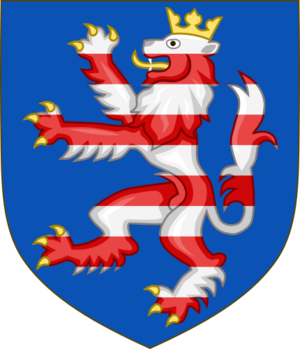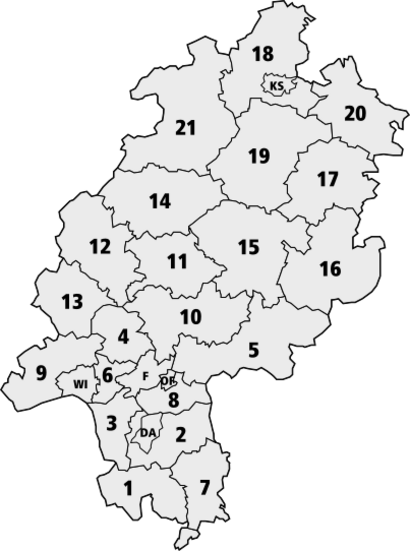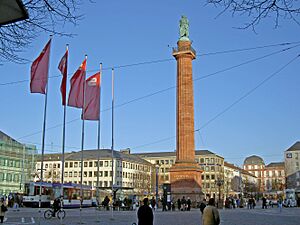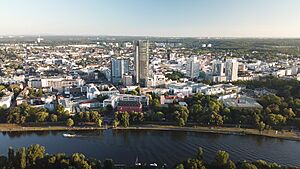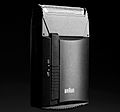Hesse facts for kids
Quick facts for kids
State of Hesse
Land Hessen (German)
|
|||
|---|---|---|---|
|
|||
| Anthem: Hessenlied "Song of Hesse" |
|||
| Country | Germany | ||
| Capital | Wiesbaden | ||
| Largest city | Frankfurt am Main | ||
| Government | |||
| • Body | Landtag of Hesse | ||
| Area | |||
| • Total | 21,114.73 km2 (8,152.44 sq mi) | ||
| Population
(2022-12-31)
|
|||
| • Total | 6,391,360 | ||
| • Density | 302.69674/km2 (783.9810/sq mi) | ||
| Demonym(s) | Hessian | ||
| GDP | |||
| • Total | €323.352 billion (2022) | ||
| • Per capita | €50,751 (2022) | ||
| Time zone | UTC+1 (CET) | ||
| • Summer (DST) | UTC+2 (CEST) | ||
| ISO 3166 code | DE-HE | ||
| NUTS Region | DE7 | ||
| HDI (2021) | 0.950 very high · 5th of 16 |
||
| Website | www.hessen.de | ||
Hesse (pronounced HESS-uh), officially called the State of Hesse (German: Land Hessen), is one of the sixteen states in Germany. Its capital city is Wiesbaden. The biggest city is Frankfurt am Main, which is also a major financial hub for the country. Other important historic cities include Darmstadt and Kassel.
Hesse covers an area of about 21,115 square kilometers (8,153 square miles). It has a population of over six million people. This makes it the seventh largest state by area and the fifth largest by population in Germany. The Frankfurt Rhine-Main area, a very large city region, is mostly located in Hesse.
As a cultural area, Hesse also includes a part of the neighboring state of Rhineland-Palatinate, known as Rhenish Hesse (Rheinhessen).
Contents
What's in a Name?
The German name Hessen comes from the name of an ancient tribe called the Hessians. This is similar to how other German regions got their names, like Bavaria or Saxony.
People from Hesse are called "Hessians." The element hassium, which is number 108 on the periodic table, was named after the state of Hesse in 1997.
A Look at Hesse's Past
The land that is now Hesse has a long and interesting history. It was officially created in 1945 after World War II.
Ancient Times
People lived in central Hesse as far back as the Upper Paleolithic period, about 13,000 years ago. Tools found in southern Hesse show that hunters were there. A very old human skull, about 12,000 years old, was found in northern Hesse.
Around 3000 BC, people built large stone tombs, like the Züschen tomb. This tomb is one of the most important ancient monuments in Central Europe. Later, around the 5th century BC, Celtic people lived here.
Around the 1st century BC, a Germanic tribe called the Chatti settled in the region. The name "Hesse" comes from this tribe. The Romans also had military camps and settlements here. However, they left after a big battle in AD 9.
By the 7th century, the Franks became powerful in the area. They built strong forts, like the Büraburg, to protect against other tribes like the Saxons.
The Holy Roman Empire
From 962, the land that would become Hesse was part of the Holy Roman Empire. In the 12th century, it became part of Thuringia. After a war (1247–1264), Hesse became its own state, called the Landgraviate of Hesse.
Hesse became very important under Philip the Magnanimous. He was a leader of Protestantism in Germany. After he died in 1567, his land was split among his four sons. The two main parts were Hesse-Kassel and Hesse-Darmstadt. These two often disagreed, especially during the Thirty Years' War.
One ruler, Frederick II (1760–1785), helped his government by lending soldiers to Great Britain. These soldiers, known as Hessians, fought in the American Revolutionary War.
Modern History
During the Napoleonic Wars in the early 1800s, Hesse's borders changed a lot. Some parts were taken by France, and new states were formed. Napoleon even made Hesse-Darmstadt a Grand Duchy.
After Napoleon's defeat in 1815, the states were reorganized. Hesse-Kassel and Hesse-Darmstadt were restored, but with some new territories.
German Empire
In 1866, after a war, Prussia took over many parts of Hesse, including Hesse-Kassel. These areas became the Province of Hesse-Nassau. The Grand Duchy of Hesse-Darmstadt kept some independence. In 1871, all of Hesse joined the new German Empire.
After World War I and II
After World War I, Hesse-Darmstadt became a republic called the People's State of Hesse. During Nazi rule (1933–1945), the state government was abolished.
After World War II, the United States created the state of Greater Hesse in 1945. This included the People's State of Hesse and most of the former Prussian areas. In 1946, Greater Hesse was officially renamed Hessen.
Hesse became an important location for NATO military bases in the 1950s. This was because it was close to the border with East Germany.
Where is Hesse?
Hesse is located in the middle of Germany. It shares borders with six other states: Lower Saxony, Thuringia, Bavaria, Baden-Württemberg, Rhineland-Palatinate, and North Rhine-Westphalia.
Most of Hesse's population lives in the southwest, in the Frankfurt Rhein-Main Region. This area includes big cities like Frankfurt am Main, Wiesbaden (the capital), Darmstadt, and Offenbach. Other large towns are Fulda in the east, and Kassel and Marburg an der Lahn in the north.
The countryside in Hesse is hilly and very green. About 42% of Hesse is covered by forests, making it one of the greenest states in Germany.


The longest rivers are the Eder and Fulda in the north, and the Lahn in the center-west. The large Main and Rhine rivers flow through the south. Hesse also has several low mountain ranges, like the Rhön, Westerwald, Taunus, and Vogelsberg. The highest point in Hesse is Wasserkuppe in the Rhön mountains, at 950 meters (3,117 feet) above sea level.
How Hesse is Governed
Hesse is a unitary state, meaning it's governed directly by the Hessian government in Wiesbaden. Local towns and cities have their own governments and can make many decisions for themselves.
Regions and Cities
The state is divided into three main administrative regions: Kassel in the north and east, Gießen in the center, and Darmstadt in the south. The Darmstadt region is the most populated, with the Frankfurt Rhine-Main area in its center.
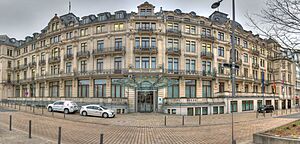

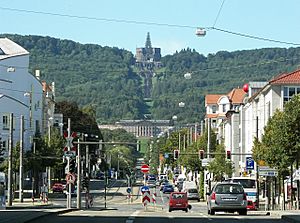
Hesse is also divided into 21 districts (called Kreise) and five independent cities. Each has its own local government.
The independent cities are:
State Symbols and Politics
Hesse has been a republic since 1918, except during the Nazi era. The state government is led by the Minister-President, who is like a prime minister.
The flag of Hesse is red and white. The Hessian coat of arms shows a lion with red and white stripes. The official song of Hesse is called "Hessenlied" ("Song of Hesse").
People of Hesse
Hesse has a population of over 6 million people. Nearly 4 million of them live in the Rhein-Main region in the south. This area includes the biggest cities like Frankfurt am Main, Wiesbaden, Darmstadt, and Offenbach.
Frankfurt is a fast-growing city. Many people from all over the world move there, making it a very diverse place. In 2015, more than half of Frankfurt's population had an immigrant background.
Languages Spoken
In Hesse, people mainly speak Standard German. However, there are also different German dialects. In the far north, some people speak Low German. Most of Hesse speaks West Middle German dialects, which can be divided into different groups like Lower Hessian, East Hessian, and Central Hessian. In the south, some people still speak South Hessian.
Culture and Arts
Hesse has a rich cultural scene.
Darmstadt is known for its Art Nouveau (Jugendstil) and modern architecture. It's also a big center for music, with the Darmstädter Ferienkurse for modern classical music and Europe's largest public jazz archive.
Frankfurt am Main is a major international cultural center. It has about 60 exhibition centers and many art galleries, like the Schirn Kunsthalle and the Städel. Famous writer Goethe was born in Frankfurt, and you can visit his birthplace. Frankfurt also has many music venues and theaters, including the largest English-speaking theater in Europe.
Kassel has beautiful palaces and parks, including Bergpark Wilhelmshöhe, which is a UNESCO World Heritage Site. The famous Brothers Grimm lived and worked in Kassel for 30 years. Their museum, Grimmwelt, explores their lives and works, including their personal copies of Children's and Household Tales. Kassel is also home to the documenta, a big modern art exhibition that happens every five years.
UNESCO World Heritage Sites
Hesse is home to several special places recognized by UNESCO:
- Bergpark Wilhelmshöhe in Kassel
- Kellerwald-Edersee National Park in North Hesse
- Lorsch Abbey
- The Messel Fossil Pit, where many ancient fossils have been found.
- The Saalburg, a Roman fort that is part of the Roman Limes.
- Darmstadt Artists' Colony
Sports in Hesse
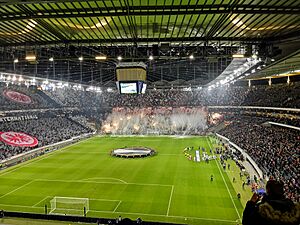
Frankfurt is home to many professional sports teams, including:
- Eintracht Frankfurt (football for men and women)
- FSV Frankfurt (men's football)
- Skyliners Frankfurt (basketball)
- Frankfurt Universe (American football)
- Löwen Frankfurt (ice hockey)
- SC 1880 Frankfurt (rugby union)
Frankfurt also hosts big sporting events like the Eschborn-Frankfurt City Loop bicycle race, the Frankfurt Marathon, and the Ironman Germany. Other notable teams outside Frankfurt include Kickers Offenbach and SV Darmstadt 98 (football).
TV and Radio
Hesse has its own public broadcasting company called HR (Hessischer Rundfunk). It offers a statewide TV channel and several regional radio stations. There are also many popular private radio stations like Hit Radio FFH and Planet Radio.
Hesse's Economy
Hesse has one of the strongest economies in Germany. Its largest city, Frankfurt am Main, is the financial capital of mainland Europe. It is home to the European Central Bank, the German Bundesbank, and the Frankfurt Stock Exchange.
Important Industries
- Chemical and Pharmaceutical: The Rhine-Main Region has many chemical and pharmaceutical companies. Big names include Sanofi, Merck, and Heraeus. These companies make medicines, chemicals, and other products.
- Metallurgy: Companies like Heraeus and Umicore work with precious metals like platinum.
- Engineering: Opel has a car factory in Rüsselsheim. Volkswagen AG has a large factory in Baunatal that makes car parts. Alstom builds locomotives in Kassel. Many other companies produce industrial machines, medical equipment, and household items like Braun shavers.
- Aerospace: Frankfurt Airport is a huge employer. Companies like Rolls-Royce and Honeywell have aviation engine and parts factories nearby.
- Optics and Electronics: The city of Wetzlar is a center for optical and precision engineering. Companies like Leica make cameras and microscopes. Other companies produce electrical transformers and solar inverters.
- IT and Telecom: Many IT and telecommunications companies are in Frankfurt and Darmstadt, including Software AG and T-Systems.
- Food and Beverage: Hesse is known for its sweets, like those from Ferrero. Famous foods include Frankfurter Sausage and Frankfurter Rindswurst. The region also produces sparkling wine, Riesling wine, mineral waters, beers, and cider.
In Frankfurt-Oberrad, special wild herbs are grown for the famous green sauce.
Typical Products from Hesse
-
Opel Insignia car
-
Riesling wine
Getting Around Hesse
Roads
Hesse has a large network of highways, including major international routes like the A3, A5, and A7. The Frankfurter Kreuz near Frankfurt Airport is one of Europe's busiest highway junctions.
Trains
Hesse has many important train lines, including high-speed routes. Frankfurt Central Station is a major hub for German trains, with over 1,100 trains passing through daily. The Frankfurt area also has a large S-Bahn (suburban train) network.
Air Travel
Frankfurt Airport is the largest airport in Germany and one of the biggest in the world, serving over 57 million passengers each year. There are also smaller airports for private planes and a few flights to holiday spots. The German air traffic control headquarters is located in Langen.
Images for kids
See also
 In Spanish: Hesse para niños
In Spanish: Hesse para niños




